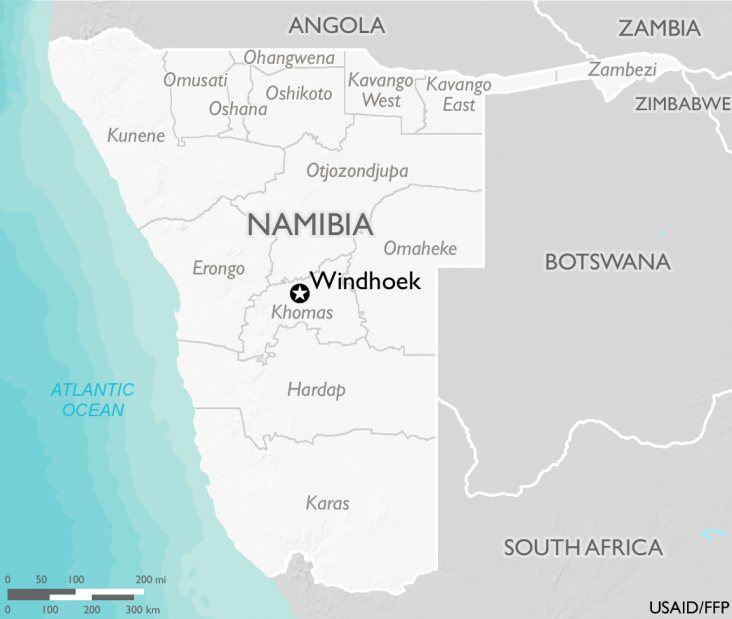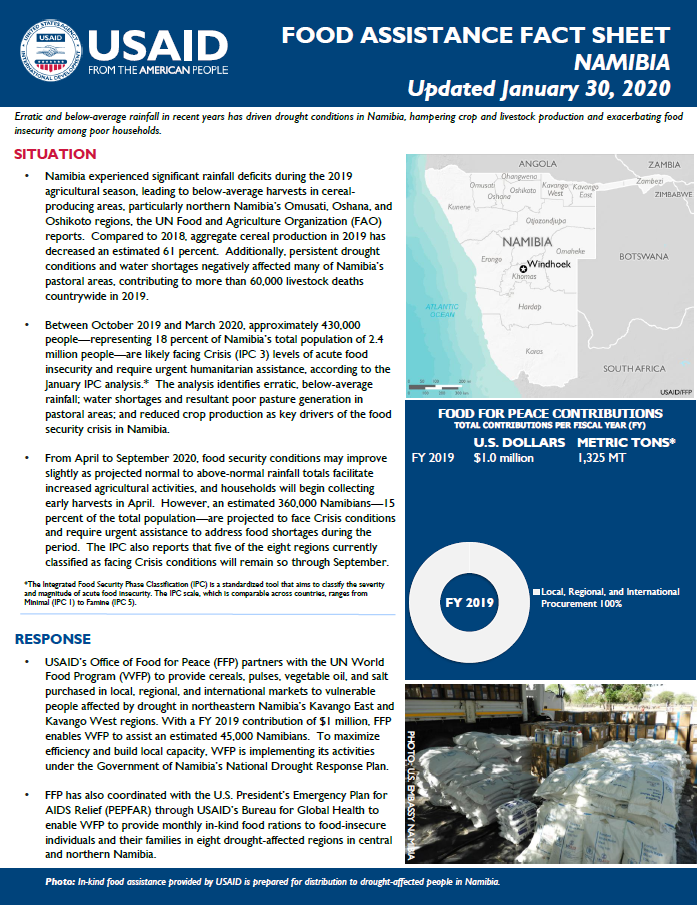Home » What We Do » Agriculture and Food Security » Food Assistance » Where We Work » Food Assistance Fact Sheet - Namibia
- What We Do
- Agriculture and Food Security
- Democracy, Human Rights and Governance
- Economic Growth and Trade
- Education
- Environment and Global Climate Change
- Gender Equality and Women's Empowerment
- Global Health
- Humanitarian Assistance
- Transformation at USAID
- Water and Sanitation
- Working in Crises and Conflict
- U.S. Global Development Lab
Speeches Shim

January 30, 2020
Erratic and below-average rainfall in recent years has driven drought conditions in Namibia, hampering crop and livestock production and exacerbating food insecurity among poor households.
Situation
- Namibia experienced significant rainfall deficits during the 2019 agricultural season, leading to below-average harvests in cereal-producing areas, particularly northern Namibia’s Omusati, Oshana, and Oshikoto regions, the UN Food and Agriculture Organization (FAO) reports. Compared to 2018, aggregate cereal production in 2019 has decreased an estimated 61 percent. Additionally, persistent drought conditions and water shortages negatively affected many of Namibia’s pastoral areas, contributing to more than 60,000 livestock deaths countrywide in 2019.
- Between October 2019 and March 2020, approximately 430,000 people—representing 18 percent of Namibia’s total population of 2.4 million people—are likely facing Crisis (IPC 3) levels of acute food insecurity and require urgent humanitarian assistance, according to the January IPC analysis.* The analysis identifies erratic, below-average rainfall; water shortages and resultant poor pasture generation in pastoral areas; and reduced crop production as key drivers of the food security crisis in Namibia.
- From April to September 2020, food security conditions may improve slightly as projected normal to above-normal rainfall totals facilitate increased agricultural activities, and households will begin collecting early harvests in April. However, an estimated 360,000 Namibians—15 percent of the total population—are projected to face Crisis conditions and require urgent assistance to address food shortages during the period. The IPC also reports that five of the eight regions currently classified as facing Crisis conditions will remain so through September.
*The Integrated Food Security Phase Classification (IPC) is a standardized tool that aims to classify the severity and magnitude of acute food insecurity. The IPC scale, comparable across countries, ranges from Minimal (IPC I) to Famine (IPC 5).
Food Assistance Fact Sheet - Namibia ![]() (pdf - 213k)
(pdf - 213k)
Response
- USAID’s Office of Food for Peace (FFP) partners with the UN World Food Program (WFP) to provide cereals, pulses, vegetable oil, and salt purchased in local, regional, and international markets to vulnerable people affected by drought in northeastern Namibia’s Kavango East and Kavango West regions. With a FY 2019 contribution of $1 million, FFP enables WFP to assist an estimated 45,000 Namibians. To maximize efficiency and build local capacity, WFP is implementing its activities under the Government of Namibia’s National Drought Response Plan.
- FFP has also coordinated with the U.S. President’s Emergency Plan for AIDS Relief (PEPFAR) through USAID’s Bureau for Global Health to enable WFP to provide monthly in-kind food rations to food-insecure individuals and their families in eight drought-affected regions in central and northern Namibia.
Food for Peace Contributions
Total Contributions:
| U.S. Dollars | Metric Tons | |
|---|---|---|
| Fiscal Year 2019 | $1.0 million | 1,325 MT |
* Metric tonnage does not reflect funding for vouchers or cash transfers.


Comment
Make a general inquiry or suggest an improvement.